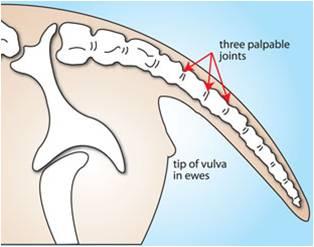Preventing flystrike - management
Preventing flystrike is more economical than treating it. Short term management tools such as strategic chemical application, crutching and shearing, and controlling worms and dags will be beneficial in the short term, whilst producers looking for a longer term solution should investigate genetic options such as breeding for reduced dags and wrinkle.
Controlling worms and dags
Scouring and therefore dag formation is usually caused by sheep worms. Follow a plan to minimise worm burdens and resulting scouring. Use worm egg counts (WEC) to check whether worm numbers are reaching significant levels while sheep are on green feed.
A dag score 4 animal can be up to seven times more susceptible to breech strike than a dag score 1 animal in the same mob. Breech cover is also an important determinant of breech strike in winter rainfall areas and its importance increases with increasing dag and wrinkle score.
WECs will quickly determine whether scouring is due to large worm burdens so that drenching will quickly control it, or if it is due to a hypersensitivity to worm larvae where few worms are present and treatment will have little effect. (This often occurs in mature sheep at the first contact of the season with large numbers of worm larvae and scouring results from an intense immune reaction which removes the larvae.) Visit the WormBoss website for regional recommendations. Identifying the most heavily scouring animals and removing them from the flock is a positive start.
Crutching and shearing
Shearing and crutching are key management tools for controlling flystrike. Shearing and crutching can give up to six weeks protection from breech strike. If sheep are scouring, this protection can be reduced to three weeks.
In a non-mulesed flock the timing of crutching or shearing becomes even more important. Shearing or crutching time should be planned to coincide with the start, or just before the usual start, of the fly season — keeping in mind withholding periods and protection periods of chemical preventatives.
The main crutching (autumn for spring shearing; spring for autumn shearing) is a key time for tidying up sheep. Time crutching for just prior to the expected fly wave period and before the sheep become excessively dirty. With unmulesed lambs it is important to crutch prior to significant dags forming so that the operation can be carried out safely and easily. Crutching can be over the board or on crutching cradle, however, if sheep are excessively dirty and unmulesed it is suggested that over the board may be the preferable method.
If shearing in autumn then all sheep should be crutched in late winter, a couple of weeks before lambing is due. A pre-lambing crutching coincides with removing wool from around the udder to reduce the risk of udder strike and makes suckling easier. Consider a pre-shearing crutch to clean up any animals, particularly if shearing is at a time of high risk. This may catch any full-woolled animals that are at risk.
Correct tail length
Lambs should be docked at the third palpable joint or to the tip of the vulva in ewes and to the same length in wethers. Docking at the correct tail length has a significant benefit in reducing stain around the breech area, as well as other advantages, such as reducing cancers, particularly in lambing ewes. Docking at the correct length can reduce dag formation.
The rate of rectal prolapses increases when sheep are docked very short or 'butt tailed'. This is thought to be because of the impact tailing has on the surrounding muscles. Some studies have demonstrated that tail docking at shorter lengths reduces the ability of sheep to 'twitch' their tails which may in turn reduce the effectiveness of deterring flies.
The Te Pari Patesco knife is a relatively new gas knife that sears and removes the tail and stretches the woolly skin producing a bare area on the top of the tail. It works in a similar fashion to normal gas knives, except for a rotating anvil system that extends the skin on the woolly side of the tail before cutting, which results in more bare skin on the dorsal tail surface and tip of the tail. This leaves a greater bare area, where wool would normally grow and may possibly reduce urine stain and dags, and thus flystrike.
Mulesing
Mulesing may not be needed on properties that are in a low risk area and on properties where producers actively select and breed for fly and worm resistance.
It is intended that the Australian Animal Welfare Standards and Guidelines for Sheep will be regulated in Western Australia in the future. Under these Standards and Guidelines, the following standards apply:
- A person performing mulesing must have the relevant knowledge, experience and skills, or be under the direct supervision of a person who has the relevant knowledge, experience and skills.
- A person must not mules sheep that are less than 24 hours old or more than 12 months old.
- A person must not mules sheep that are 6–12 months old without using appropriate pain relief.
- A person must not mules sheep showing signs of debilitating disease, weakness or illthrift.
- A person mulesing sheep must only remove wool-bearing skin.
For further information on this, please see our page on best practice marking of lambs.

